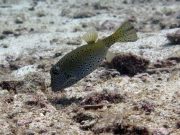Diving with Boxfishes
Lanta Marine Life | Ostraciidae
Boxfish are, as the name implies, box-shaped, with an armored and rigid body which in most cases would inhibit locomotion. This disadvantage is offset by the boxfish's shape which has led to the evolution of an unusual swimming style. They are often spotted on sane or rubble close to the reef edge on Koh Lanta diving trips.
Boxfish are normally solitary animals, gathering in the spring in small groups consisting of 1 male and 2 - 4 females for breeding.
All documented species of Boxfish adopt a spawning rise strategy. On sunset or sunrise the male spends his time flashing bright colours and dancing around the female. Once satisfied, the female will swim quickly to the surface or shallow open water (the rise), and the male then hums to the female, loud enough for a diver to hear. The eggs are then fertilised and released and the boxfish return back to safer, sheltered and protected parts of the reef.
This pelagic spawning technique means that once the eggs are released, they are heavily dispersed by currents into the open ocean. The female can produce a number of eggs daily for around a month. One benefit of this technique is that predators cannot feed on the whole batch of eggs however, the chances of a hatched egg drifting to a suitable place of refuge for a newborn to live and survive are slim, leading to a high mortality rate in the reproduction of Boxfish.
3 species found on this page:
Yellow Boxfish
(Ostracion cubicus)
The Yellow Boxfish (Ostracion cubicus) is a species of boxfish found in relative shallow waters, usually among corals and complex structures which can provide protection from potential predators.
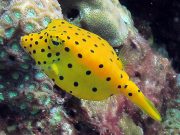
Ostracion cubicus @ Koh Haa
When juvenile, the Yellow Boxfish is bright yellow in color with black spots, and easy to identify. As they begin to mature the number of spots decreases and the yellow blends into almost a dirty, mustard colour.
Very old specimens will have blue-grey to black colouration with faded yellow. As they grow, the body elongates and a bump forms on the snout tip.
Juvenile - Bright yellow with black spots on head and body. Possibly starting to grow a small bump on snout tip.
Young Adult - Yellowish brown to olive coloured, with black spots on the head and a few dark ringed bluish spots on the body. Young adults will have a small bump on the snout tip.
Intermediate Adult - Tan to yellowish brown colour with dark ringed bluish spots. Fins are blue with black spots and may have blue/black or yellow crinkled line markings on the head and base of the pectoral fins. Obvious bump on the snout tip.
Large Adult - Brownish purplish or blue/greyish with indistinct/faded spots. Often yellow crinkled line markings on the head and yellowish tail base. Bump on the snout tip. Can reach a maximum length of 45 centimetres (18 in).
The Yellow Boxfish feeds mainly on algae, but will also feed on sponges, crustaceans and molluscs. The fish's diet consists of marine algae, worms, crustaceans, molluscs, and small fish. Using its puckered lips, it blows small bursts of water at the corals and sand to reveal anything that might be hiding.
When stressed or injured the Yellow Boxfish releases the neurotoxin tetrodoxin (TTX) from special cells covering their entire skin. This cloud of poison can be fatal to fish in the surrounding waters. The bright yellow colour and black spots are also a form of warning coloration (Aposematism) to any potential predators.
Horn-nosed Boxfish
(Ostracion rhinorhynchos)
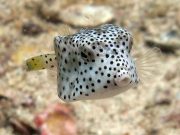
Ostracion rhinorhynchos @ Koh Bida
The Horn-nose Boxfish has a carapace that is pentagonal (six sides) in cross-section. The body ridges are relatively sharp-edged, and lack spines. There is a distinct bump on snout.
This species is whitish with black spots on the back and caudal peduncle. Large fish are darker with more dark spots.
This is a generally uncommon species and is found singly or in pairs over channels, coral patches and rubble substrates of sandy lagoons and sheltered inner reefs.
Feeds on benthic invertebrates.
Whitespotted Boxfish
(Ostracion meleagris)
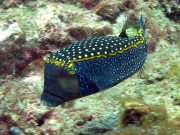
Male Ostracion meleagris @ Koh Bida
The male Whitespotted Boxfish has a black back with white spots and blue sides with bright yellow spots and bands.
Female and juvenile Whitespotted Boxfish have a black or dark brown body with white spots.
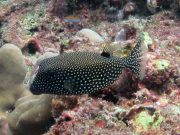
Female Ostracion meleagris @ Koh Haa
The Whitespotted Boxfish grows to 25 cm. The diet includes molluscs, bristle worms, sponges, crustaceans and algae.
Diving with Boxfishes around Koh Lanta
Scuba Diving & Snorkel Trips
If you'd love a chance to spot Boxfishes on one of our daily high season diving trips from Koh Lanta then send us an email to info@diveandrelax.com.
Join our high season speedboat dive trips to some of Thailand's best dive sites and enjoy small groups, short journey times, with a focus on great personal service, safety and fun.
Not yet a certified diver? Learn to Scuba Dive on Koh Lanta with the 3 day SSI Open Water Diver course.
Book online to save 10% on dive trips and scuba courses on Koh Lanta.
Find Out More
Indo-Pacific Marine Life Guides
- Allen, G., Steene, R., Humann, P., DeLoach, N. (2003) Reef Fish Identification, Tropical Pacific. Jacksonville, FL., USA: New World Publications, Inc., ISBN 1-878348-36-1.
- Humann, P., DeLoach, N., (2010) Reef Creature Identification, Tropical Pacific. Jacksonville, FL., USA: New World Publications Inc., ISBN 978-1-878348-44-9
- Debelius, H. (2013) Indian Ocean Reef Guide. Frankfurt, Germany: IKAN - Unterwasserarchiv, ISBN 978-3-939767-52-7.
- Debelius, H. (2004) Nudibranchs and Sea Snails, Indo-Pacific Field Guide. Frankfurt, Germany: IKAN - Unterwasserarchiv, ISBN 3-925919-51-1
- Erhardt, H., Knop, D. (2015) Corals Indo-Pacific Field Guide. Frankfurt, Germany: IKAN - Unterwasserarchiv, ISBN 3-925919-69-4.
- Veron J.E.N., Stafford-Smith M.G., Turak E. and DeVantier L.M. (2016). Corals of the World


